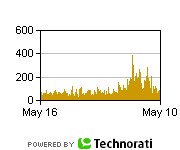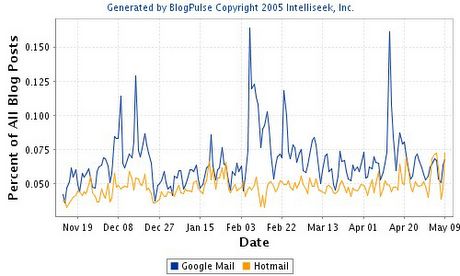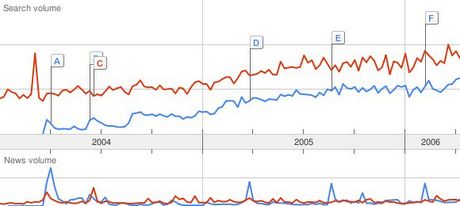What are people searching for ? Is soccer a more popular game or cricket with web surfers ? What topics are more popular with bloggers ? Are they writing more about Google or Yahoo ?
All these statistics and more are now available to anyone using some free tools. Here we compare the three most popular buzz-tracking services - Google, Technorati, Blogpulse: Read the pros and cons of each and choose the one which best suits your needs.
Technorati Charts - Big Daddy Technorati tracks some 40 million blogs - if someone, somewhere writes about somethings, it's more likely to be indexed by Technorati than other other service.
 Technorati Charts are a recent addition that tracks how may blog posts mentioned a particular keyword or phrase in a given time. The charts. generated in real time. can be embedded in websites.
Technorati Charts are a recent addition that tracks how may blog posts mentioned a particular keyword or phrase in a given time. The charts. generated in real time. can be embedded in websites.
It's a nice tool for egosurfing or when you are a popular guy like scoble. (see chart on the right)
However, you cannot compare two search terms in a single technorati chart. Also, the service is slow at times and chart generation may take a while.
Blogpulse Trend Search - This a useful trend watching tool from BlogPulse, a blog search engine. Blogpulse is more useful when you are interested in the following kind of information:

» How many people have blogged about GMail vs Hotmail in the past three months ? (see graph)
» You want to compare 2-3 URLs and watch the number of blog posts linking to them over time
The (dis)advantage of Blogpulse is that it tracks only blogs (or sites with feeds). You can compare only three terms per search. Blogpulse shows you information for a fixed time frame: 1, 2, 3 or 6 months. The Trend Graphs can be generated only from the Blogpulse website - they don't provide a simple URL with search parameters like Technorati.
Google Trends - The service is just like a day old infant but mature and powerful enough to kill competition. First it queries the most popular search engine's extensive database and second, it's more flexible and feature rich.
Here are some of the unique ways in which Google trend can be used that set it miles apart from competion:
» Help you find which queries originate from which regions of the world (including cities)
» Are people in Australia searching for soccer more than people in Ireland ?
» What more popular drink in your country - Coke or Pepsi
Above all, Google lets you limit your searches to individual months, years or the entire period. It's the only service you need to watch search trends. Google seems to have made a mark again.
The only drawback with Google Trend is that it doesn't provide the real statistics or numbers - Graphs are only relative which gives no idea about the real search data.

All these statistics and more are now available to anyone using some free tools. Here we compare the three most popular buzz-tracking services - Google, Technorati, Blogpulse: Read the pros and cons of each and choose the one which best suits your needs.
Technorati Charts - Big Daddy Technorati tracks some 40 million blogs - if someone, somewhere writes about somethings, it's more likely to be indexed by Technorati than other other service.
 Technorati Charts are a recent addition that tracks how may blog posts mentioned a particular keyword or phrase in a given time. The charts. generated in real time. can be embedded in websites.
Technorati Charts are a recent addition that tracks how may blog posts mentioned a particular keyword or phrase in a given time. The charts. generated in real time. can be embedded in websites. It's a nice tool for egosurfing or when you are a popular guy like scoble. (see chart on the right)
However, you cannot compare two search terms in a single technorati chart. Also, the service is slow at times and chart generation may take a while.
Blogpulse Trend Search - This a useful trend watching tool from BlogPulse, a blog search engine. Blogpulse is more useful when you are interested in the following kind of information:

» How many people have blogged about GMail vs Hotmail in the past three months ? (see graph)
» You want to compare 2-3 URLs and watch the number of blog posts linking to them over time
The (dis)advantage of Blogpulse is that it tracks only blogs (or sites with feeds). You can compare only three terms per search. Blogpulse shows you information for a fixed time frame: 1, 2, 3 or 6 months. The Trend Graphs can be generated only from the Blogpulse website - they don't provide a simple URL with search parameters like Technorati.
Google Trends - The service is just like a day old infant but mature and powerful enough to kill competition. First it queries the most popular search engine's extensive database and second, it's more flexible and feature rich.
Here are some of the unique ways in which Google trend can be used that set it miles apart from competion:
» Help you find which queries originate from which regions of the world (including cities)
» Are people in Australia searching for soccer more than people in Ireland ?
» What more popular drink in your country - Coke or Pepsi
Above all, Google lets you limit your searches to individual months, years or the entire period. It's the only service you need to watch search trends. Google seems to have made a mark again.
The only drawback with Google Trend is that it doesn't provide the real statistics or numbers - Graphs are only relative which gives no idea about the real search data.
